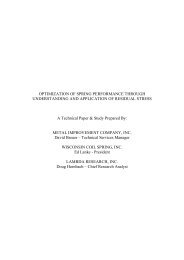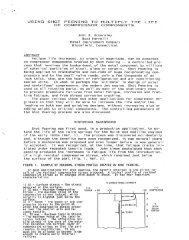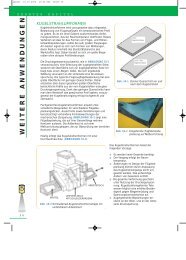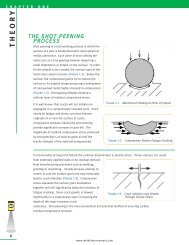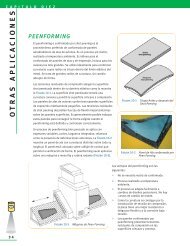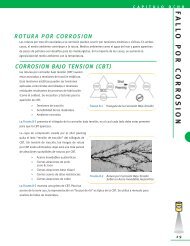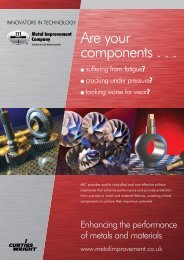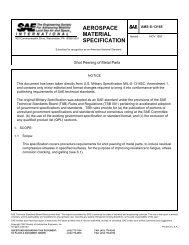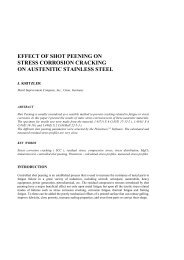MIC Green Book
MIC Green Book
MIC Green Book
You also want an ePaper? Increase the reach of your titles
YUMPU automatically turns print PDFs into web optimized ePapers that Google loves.
C H A P T E R S E V E N<br />
C O NTACT FAILURE<br />
26<br />
Pitting failures initiate due to Hertzian and sliding contact stresses near the pitch line. When asperities<br />
from mating surfaces make contact, the loading is a complex combination of Herzian and tensile<br />
stresses. With continued operation, a<br />
micro-crack may initiate. Crack growth<br />
will continue until the asperity<br />
separates itself leaving a "pit".<br />
A condition of mixed lubrication is very<br />
susceptible to pitting failure. This occurs<br />
when the lubricant film is not quite thick<br />
enough to separate the surfaces and<br />
actual contact occurs between the<br />
asperities. Figure 7-3 shows a gear<br />
flank and the mechanisms that cause<br />
pitting [Ref 7.2].<br />
Shot peening has been proven to be highly<br />
beneficial in combating pitting fatigue when<br />
followed by a surface finish improvement process. By removing the asperities left from shot peening, the<br />
contact area is distributed over a larger surface area. It is important when finishing the shot peened<br />
surface to not remove more than 10% of the compressive layer. Please see Chapter 10 for photomicrographs<br />
of a shot peened and isotropically finished surface using the C.A.S.E. SM Figure 7-3 Pitting Failure Schematic<br />
process.<br />
GALLING<br />
Galling is an advanced form of adhesive wear that can occur on materials in sliding contact with no or only<br />
boundary lubrication. In its early stages it is sometimes referred to as scuffing. The adhesive forces<br />
involved cause plastic deformation and cold welding of opposing asperities. There is usually detachment of<br />
metal particles and gross transfer of fragments between surfaces. When severe, seizure may occur.<br />
Shot peening can be beneficial for surfaces that gall particularly when the materials are capable of work<br />
hardening. The cold worked surface also contains dimples that act as lubricant reservoirs. The following<br />
materials have demonstrated positive response to galling with the assistance of shot peening: Inconel 718<br />
and 750, Monel K-500 and alloys of stainless steel, titanium and aluminum.<br />
REFERENCES:<br />
7.1 Figure 7-1, Unigraphics Solutions, Inc. website (www.ugsolutions / www.solid-edge.com), June 2000<br />
7.2 Hahlbeck; Milwaukee Gear; Milwaukee, WI / Powertrain Engineers; Pewaukee, WI<br />
www.metalimprovement.com



